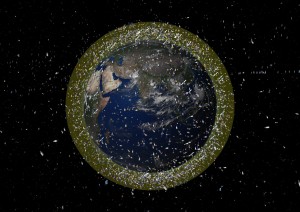
70% of all catalogued objects are in low-Earth orbit (LEO), which extends to 2000 km above the Earth’s surface. To observe the Earth, spacecraft must orbit at such a low altitude. The spatial density of objects increases at high latitudes. Note: The debris objects shown in the images are an artist’s impression based on actual density data. However, the debris objects are shown at an eggagerated size to make them visible at the scale shown.
Credit ESA.
The New York Times reported the other day that two communications satellites – one American. one Russian – collided in space.
“This is a first, unfortunately,†Nicholas L. Johnson, chief scientist for orbital debris at the National Aeronautics and Space Administration, said of the collision.
It happened some 490 miles above northern Siberia, at around noon Eastern time. Two communications satellites — one Russian, one American — cracked up in silent destruction. In the aftermath, military radars on the ground tracked large amounts of debris going into higher and lower orbits.
“Nothing to this extent†has ever happened before, Mr. Johnson said. “We’ve had three other accidental collisions between what we call catalog objects, but they were all much smaller than this,†the objects always very small and moderate in size.
The communication satellites, he added, “are two relatively big objects.â€
If you’re wondering why NASA has someone in charge of orbital debris, that picture above illustrates the problem in a somewhat exaggerated form. While the threat to the space station is viewed as minimal for now, later on in the report there’s a reference to a bigger problem:
Mr. Johnson, who works at the Johnson Space Center in Houston, said the new swarms of whirling debris might also eventually pose a threat to other satellites in an orbital chain reaction.
About that chain reaction … Two years ago the New York Times reported:
Early this year, after a half-century of growth, the federal list of detectable objects (four inches wide or larger) reached 10,000, including dead satellites, spent rocket stages, a camera, a hand tool and junkyards of whirling debris left over from chance explosions and destructive tests.
Now, experts say, China’s test on Jan. 11 of an antisatellite rocket that shattered an old satellite into hundreds of large fragments means the chain reaction will most likely start sooner. If their predictions are right, the cascade could put billions of dollars’ worth of advanced satellites at risk and eventually threaten to limit humanity’s reach for the stars.
Federal and private experts say that early estimates of 800 pieces of detectable debris from the shattering of the satellite will grow to nearly 1,000 as observations continue by tracking radars and space cameras. At either number, it is the worst such episode in space history.
If I understand the article, the chain reaction that observers fear, would create a ring of debris around Earth that would be nearly impossible to penetrate.
Cascade warnings began as early as 1978. Mr. Kessler and his NASA colleague, Burton G. Cour-Palais, wrote in The Journal of Geophysical Research that speeding junk that formed more junk would produce “an exponential increase in the number of objects with time, creating a belt of debris around the Earth.â€
(The Times also provided an interactive graphic to illustrate the problem.)
Whether or not the cascade ever occurs, it’s likely that there will be more collisions like the one that occurred this week.
Crossposted on Soccer Dad.
